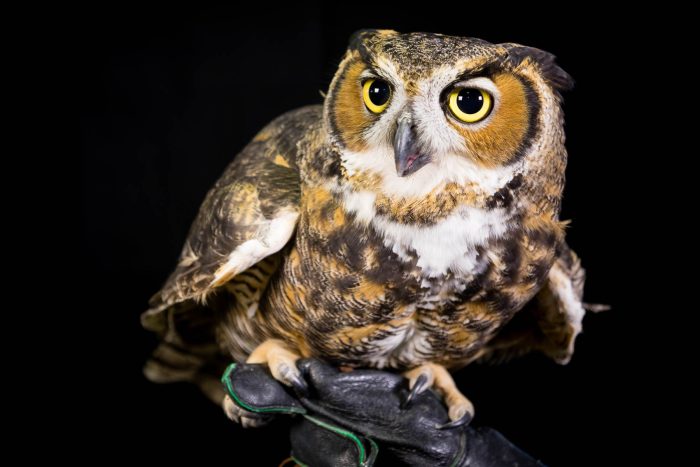Great Horned Owl
Bubo virginianus
The great horned owl is a large, tufted owl that inhabits almost all of North America.
This section shows one large critter image at a time. Use the thumbnails that follow to select a specific image to display here.

This gallery contains a grid of small thumbnails. Selecting a thumbnail will change the main image in the preceding section.
Appearance
Great horned owls get their name from the two tufts of horn-like feathers on the top of their head. The feathers are not horns or ears and are known as “plumicorns,” their exact function is unknown. The plumicorns might help camouflage the birds. Their facial discs are reddish-brown, gray and black. They have a white throat patch. They have mottled gray, brown and white feathers on their body. Long light-colored feathers cover their legs and feet.
Feeding
Great horned owls prefer to hunt at night but will occasionally hunt during the day. They like to sit on a high perch and fly to catch their prey. Their incredible eyesight and hearing help them target prey. They will catch prey in their talons and eat it in place or take it to a safe location.
Predators
Great horned owl eggs and nestlings are most vulnerable to predation. Foxes, raccoons, crows, ravens and other raptors will prey on the eggs and young birds. Adults are rarely preyed upon.
Flight
Like many owls, great horned owls have serrated feathers which allows them to fly silently and ambush prey.
Voice
The great horned owl is often heard making a deep call of hoo-hoo-hoo-hoo. Males and females will call back and forth to each other during courtship. When they feel threatened they may scream, hiss or snap their bills. Young owls will scream when begging for food from their parents. Males are smaller than females, but they have a larger voicebox which gives them a deeper pitch.
Reproduction and life cycle
To begin courtship, males will call out to females, puff their throat feathers and bow. If a female accepts the male, they will both bow and hoot at each other. Owl pairs are often monogamous and will remain a pair for several years. Courtship begins in the fall and mates are picked by December and a nest location will be determined by January or February. They will frequently use abandoned nests created by other birds rather than building their own. The female will lay one to four eggs, most commonly two, and incubate the eggs for about one month. During this time, the male will hunt for both himself and the female and bring food to the nest. Nestlings stay in the nest for about six weeks and fledge at about two to three months old but may continue to be cared for by their parents for several more weeks.
Did you know?
● Great horned owls are the largest tufted owl species in North America.
● Great horned owls can crush their prey with 28 pounds of force with their talons.
● Groups of crows may mob great horned owls. The crows will gather from multiple locations and will divebomb and harass the owls, which are their most dangerous predator.
Sources and additional information
- Woodland Wildlife Spotlight: Great Horned Owl - University of Maryland Extension
- Maryland Birds: Great horned Owl - Maryland Department of Natural Resources
- Great Horned Owl - All About Birds
